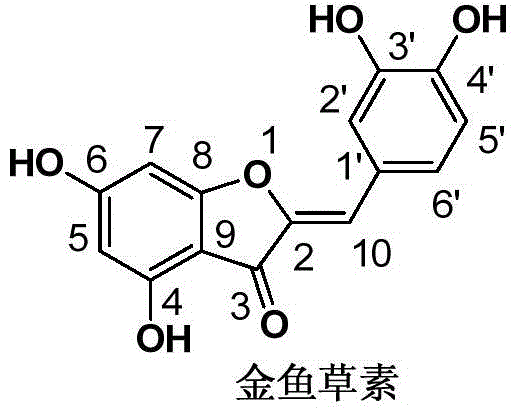Method for extracting snapdragon from water chestnut peel
A technology of snapdragon and water chestnut skin, applied in the direction of organic chemistry and the like, can solve unseen and other problems, and achieve the effects of low production cost, good separation effect, and scientific and reasonable design.
- Summary
- Abstract
- Description
- Claims
- Application Information
AI Technical Summary
Problems solved by technology
Method used
Image
Examples
Embodiment 1
[0021] In the extraction tank, add 800g of fresh water chestnut skin powder and 6.4L of 50% by volume acetone aqueous solution, extract at 50°C for 2 hours, extract 3 times in total, filter, combine the filtrates, concentrate under reduced pressure into a paste, and obtain 120g of extract .
[0022] Add 900 mL of water to the extract to make a turbid liquid, add 1.8 L of ethyl acetate to extract three times, combine the extracts, concentrate under reduced pressure, and obtain 10.5 g of the extract.
[0023] Dissolve the extract in 25mL of methanol, then add 250mL of water to make a suspension, transfer it to a 1kg D101 macroporous resin chromatography column for adsorption, after static adsorption, wash with water until the effluent is colorless, and then use 25% volume percentage 800mL of methanol aqueous solution to wash away the polar glycoside impurities, and finally eluted with 50% methanol aqueous solution, detected by thin-layer chromatography, collected and combined th...
Embodiment 2
[0026] In the extraction tank, add 800g of fresh chestnut skin powder and 1.6L of 75% volume percent methanol aqueous solution, extract at 70°C for 2.5h, filter, and extract 3 times in total, combine the filtrates, concentrate under reduced pressure to obtain 150g of extract .
[0027] Add 750 mL of water to the extract to make a turbid liquid, then add 1.5 L of ethyl acetate to extract 3 times, combine the extracts, concentrate under reduced pressure, and obtain 12.0 g of the extract.
[0028] Dissolve the extract in 24mL of methanol, then add 240mL of water to make a suspension, transfer it to a 1kg S-8 macroporous resin chromatography column for adsorption, after static adsorption, wash with water until the effluent is colorless, and then use 25 800mL of aqueous methanol solution of % volume percentage washes away the polar glycoside impurities, and finally elutes with 50% aqueous methanol solution by volume percentage, detects by thin-layer chromatography, collects the ant...
Embodiment 3
[0031] In the extraction tank, add 800g of fresh water chestnut skin powder and 8.0L of 70% ethanol aqueous solution by volume, extract at 65°C for 1.5h, extract 2 times in total, filter, combine the filtrates, concentrate under reduced pressure into a paste, and obtain the extract 100g.
[0032] Add 800 mL of water to the extract to make a turbid liquid, add 1.6 L of ethyl acetate to extract three times, combine the extracts, concentrate under reduced pressure, and obtain 9.5 g of the extract.
[0033] Dissolve the extract in 19mL of methanol, add 190mL of water to make a suspension, transfer it to a chromatographic column of 1kg D101 macroporous resin for adsorption, after static adsorption, wash with water until the effluent is colorless, and then use 25% volume percentage 800mL of ethanol aqueous solution washes away the polar glycoside impurities, and finally elutes with 45% ethanol aqueous solution by volume percentage, detects by thin-layer chromatography, collects and ...
PUM
 Login to View More
Login to View More Abstract
Description
Claims
Application Information
 Login to View More
Login to View More - R&D
- Intellectual Property
- Life Sciences
- Materials
- Tech Scout
- Unparalleled Data Quality
- Higher Quality Content
- 60% Fewer Hallucinations
Browse by: Latest US Patents, China's latest patents, Technical Efficacy Thesaurus, Application Domain, Technology Topic, Popular Technical Reports.
© 2025 PatSnap. All rights reserved.Legal|Privacy policy|Modern Slavery Act Transparency Statement|Sitemap|About US| Contact US: help@patsnap.com

